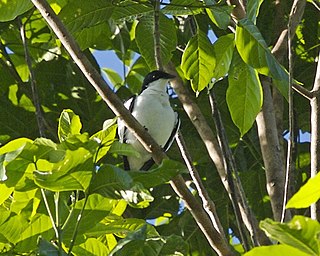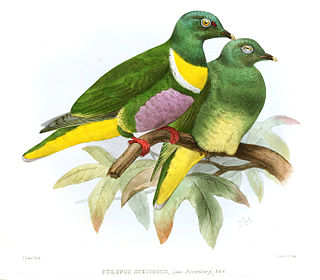
The dusky myzomela or dusky honeyeater is a small, brown bird that is a common resident of the Aru Islands, southern New Guinea and northern and eastern Australia, where there are two separated populations, one in the Top End, another from Cape York Peninsula along the east coast as far south as the New South Wales border, though the species is rare south of Rockhampton. The Moluccan myzomela, red-tinged myzomela, and Biak myzomela were formerly considered conspecific, but was split as distinct species by the IOC in 2021.

The scarlet myzomela or scarlet honeyeater is a small passerine bird of the honeyeater family Meliphagidae native to Australia. It was first described by English ornithologist John Latham in 1801. At 9 to 11 centimetres long, it is the smallest honeyeater in Australia. It has a short tail and relatively long down-curved bill. It is sexually dimorphic; the male is a striking bright red with black wings, while the female is entirely brown. The species is more vocal than most honeyeaters, and a variety of calls have been recorded, including a bell-like tinkling.

The black honeyeater is a species of bird in the honeyeater family Meliphagidae and the sole species in the genus Sugomel. The black honeyeater exhibits sexual dimorphism, with the male being black and white while the female is a speckled grey-brown; immature birds look like the female. The species is endemic to Australia, and ranges widely across the arid areas of the continent, through open woodland and shrubland, particularly in areas where the emu bush and related species occur.

The black-browed triller is a species of bird in the family Campephagidae. It is found in northern New Guinea. Its natural habitats are subtropical or tropical moist lowland forests and subtropical or tropical mangrove forests. The Biak triller was formerly considered a subspecies.
The Biak monarch, or Biak monarch flycatcher, is a species of bird in the family Monarchidae. It is endemic to Biak Island, Indonesia.

The island monarch is a species of bird in the family Monarchidae. It is found from Sulawesi to the Solomon Islands. Its natural habitats are subtropical or tropical moist lowland forests and subtropical or tropical moist montane forests.

Myiagra is a genus of passerine birds in the family Monarchidae, the monarch flycatchers, sometimes referred to as the broad-billed flycatchers or simply broadbills native to Australasia.

Myzomela is a genus of bird in the honeyeater family Meliphagidae. It is the largest genus of honeyeaters, with 33 species, and the most geographically widespread. It ranges from Indonesia to Australia and into the islands of the Pacific Ocean as far as Micronesia and Samoa.

The red myzomela is a species of bird in the family Meliphagidae. It is found in New Guinea and New Britain. The reddish myzomela of New Ireland was formerly considered conspecific, but was split as a distinct species by the IOC in 2021.

The red-headed myzomela or red-headed honeyeater is a passerine bird of the honeyeater family Meliphagidae found in Australia, Indonesia, and Papua New Guinea. It was described by John Gould in 1840. Two subspecies are recognised, with the nominate race M. e. erythrocephala distributed around the tropical coastline of Australia, and M. e. infuscata in New Guinea. Though widely distributed, it is not abundant within this range. While the IUCN lists the Australian population of M. e. infuscata as being near threatened, as a whole the widespread range means that its conservation is of least concern.

The red-collared myzomela is a species of bird in the family Meliphagidae. It is found in New Guinea. The long-billed myzomela of Goodenough Island was formerly considered conspecific, but was split as a distinct species by the IOC in 2021.

The black-breasted myzomela or red-rumped myzomela is a species of bird in the family Meliphagidae. It is found on Timor island. Its natural habitat is subtropical or tropical dry forests.

The northern fantail is a species of bird in the family Rhipiduridae. It is found in New Guinea and northern Australia . Its natural habitats are subtropical or tropical moist lowland forests and subtropical or tropical mangrove forests. The Biak fantail was formerly considered a subspecies.

The Geelvink fruit dove is a species of bird in the family Columbidae. It is native to several islands, including Biak, Supiori, Numfor, and the smaller Padaido Islands, collectively known as the Schouten or Geelvink Islands, which lie north of New Guinea.
The Moluccan myzomela is a species of bird in the family Meliphagidae. It was formerly considered a subspecies of the dusky myzomela, but was split as a distinct species by the IOC in 2021. It is found in the Maluku Islands. Its natural habitat is subtropical or tropical moist lowland forests.
The red-tinged myzomela is a species of bird in the family Meliphagidae. It was formerly considered a subspecies of the dusky myzomela, but was split as a distinct species by the IOC in 2021. It is found in the Maluku Islands. Its natural habitat is subtropical or tropical moist lowland forests.
The reddish myzomela is a species of bird in the family Meliphagidae. It is found in New Ireland. It was formerly considered a subspecies of the red myzomela, but was split as a distinct species by the IOC in 2021.
The long-billed myzomela is a species of bird in the family Meliphagidae. It is found on Goodenough Island. It was formerly considered a subspecies of the red-collared myzomela, but was split as a distinct species by the IOC in 2021.












